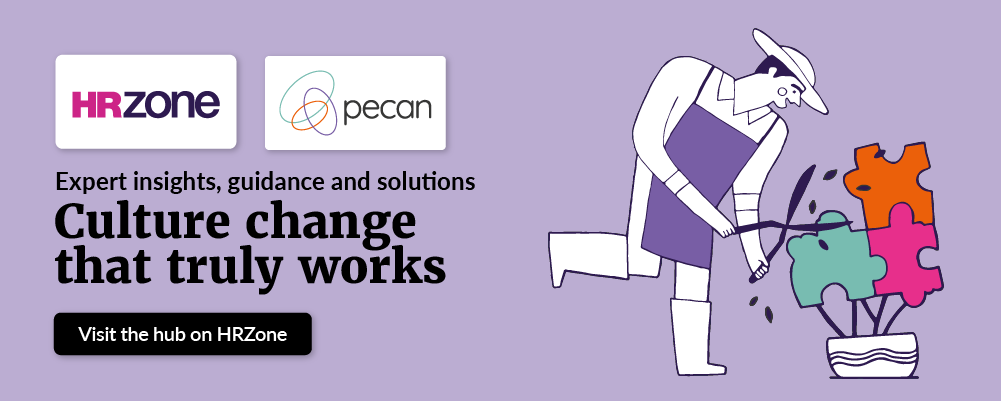According to a study by McKinsey, crisis-fuelled experimentation was the main driver of organic growth for companies during the pandemic. Companies that refocused quickly, invested more resources, and experimented with new technologies accelerated faster than others.
The trend continues as the economic and political climate remains volatile and organisations attempt to rapidly adapt to AI advances and societal changes. Harvard Business Review points out that to successfully innovate, companies need to make experimentation an integral part of everyday life – even when budgets are tight.
In Pecan’s recent Culture Fit for the Future research, respondents told us that innovation and continuous improvement are difficult to prioritise. This is especially the case when teams are overwhelmed by busy change agendas and ever-changing environments, and where employee turnover is high.
One of the three themes for a future-fit culture is to embed ‘everyday experimentation’ into the organisation’s culture. As well as driving growth, a culture of experimentation fosters diversity, inclusivity and employee engagement. As colleagues feel valued for their contribution, they develop and grow while the organisation benefits from value creation at pace. All without disrupting the ‘business as usual’ operation.
Key traits in a workplace culture of everyday experimentation
What is foundational to everyday experimentation? Here, we present three key traits uncovered in the Culture Fit for the Future research.
1. Inclusivity
The highest scoring trait in our research, an inclusive culture is where people are welcomed for who they are, the unique qualities they bring and their potential. Diversity is valued and psychological safety is high, with participation actively encouraged.
Involving a range of experiences, perspectives and ways of thinking is essential to effective experimentation. With the right conditions, diverse teams generate more unconventional ideas and implement them, more effectively than homogenous ones.
2. Agility
The pandemic was a great example of agility in practice, with many respondents sharing how surprised they were at the speed with which their organisation adapted.
For experimentation to add value to the bottom line, successful experiments need to be adopted and embedded skilfully and efficiently. Where needed, priorities must be re-negotiated to ensure capacity to deliver. A new level of high-trust collaboration and challenge is required to stop projects that are no longer needed and focus resources on the priorities.
3. Learning
Unsurprisingly, a learning and growth mindset is essential in a culture of everyday experimentation. Curiosity, openness and emotional and social intelligence are key – as is resilience to thrive in ambiguity and bounce-back from experiments that fail.
A learning mindset requires the humility to be led by customer and employee data rather than personal biases and pet projects. Regular reflection to understand what has worked and what needs to be done differently improves future experimentation outcomes.
Discover more about developing a learning culture that inspires curiosity.
Five ways organisations can foster a culture of experimentation
- Define what you mean by experimentation. Often ‘innovation’ can feel like the prerogative of a Research and Development team, not something that any team can take part in. Make it clear that small improvements are valued as much as new products or services – cumulatively they can have as big an impact
- Set the strategic context for experimentation. Explain why it’s needed in the context of your organisation’s purpose, values and priority goals
- Share customer and employee data. Help everyone understand the problems that need to be solved so that experimentation has a clear focus
- Role model experimental mindset and behaviours. Instead of competing in siloes, ensure leaders and managers place importance on working together to innovate. Be curious, have the humility to be OK with knowledge gaps and making mistakes, and make space for other people to come up with ideas
- Celebrate and reward experimentation. Include experiments that were not successful, recognising the learning that emerged from these
Five ways teams can foster a culture of experimentation
- Establish routines for regular experimentation, for example monthly brainstorms or hackathons
- Include people who think differently, people who reflect your customer demographic and ‘critical friends’ who are willing to challenge groupthink
- Disrupt the standard meeting format. Change the location of where people get together to experiment. Use ice-breakers and exercises to help people feel and think differently from the start
- Build psychological safety. Use a mix of approaches to seek views and ideas. Ensure people feel valued for their contribution and encouraged to think differently
- Be disciplined about which ideas to pursue and which to stop, to prevent overwhelm – get good at saying ‘no’ or ‘not yet’. Encourage employees to regularly review priorities and stop activity that is not value-adding
Does my organisation already have an experimental culture?
It can be difficult to assess your own organisation’s culture. If innovation and experimentation are critical to growth and sustainability, it may be worth investing in a third-party culture review.
In the meantime, these questions are a good place to start:
- How clear is the ‘line of sight’ from everyone’s role to the organisation’s priorities?
- When was the last time a ‘grass roots’ employee idea was implemented?
- How often are projects stopped because they are no longer a priority?
If you need support to create an experimental culture that adds value to your bottom line, find out more about Pecan’s Culture Change that Works services.







